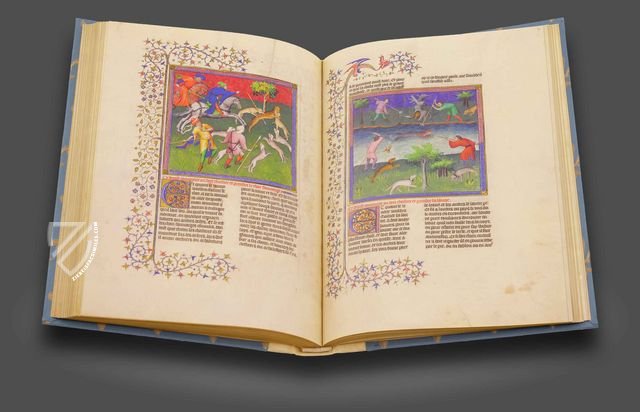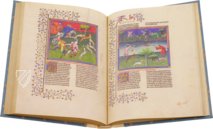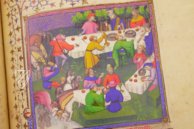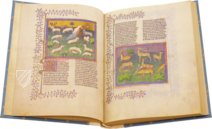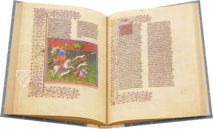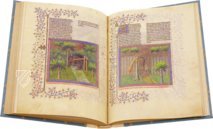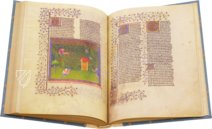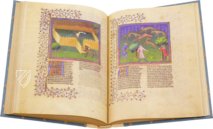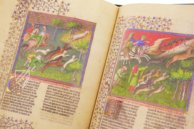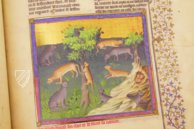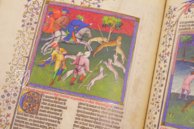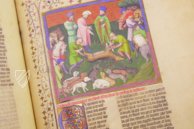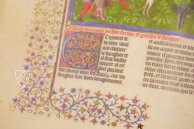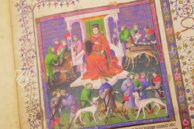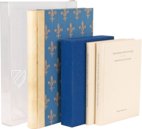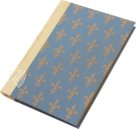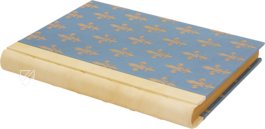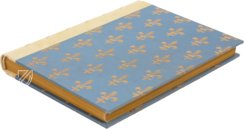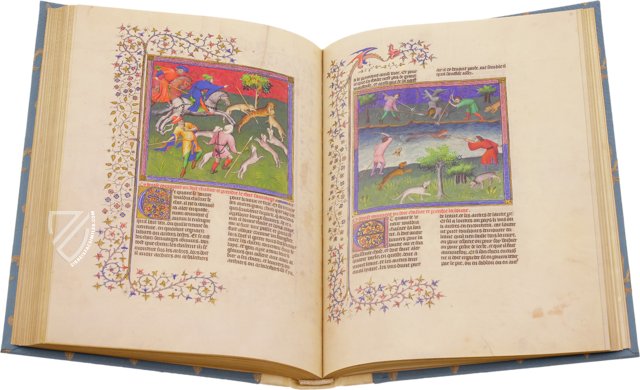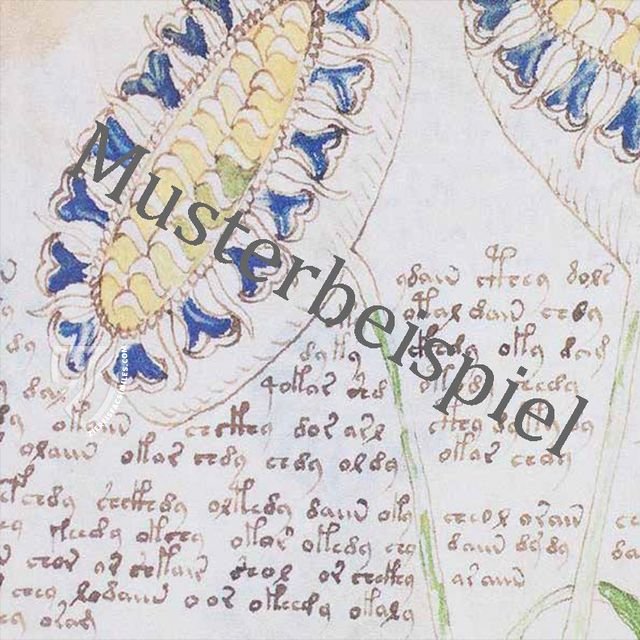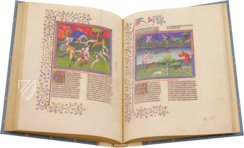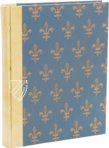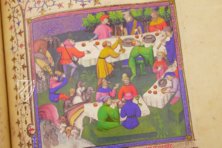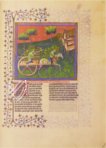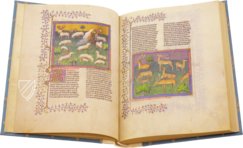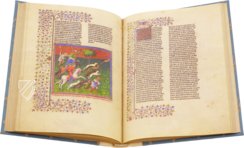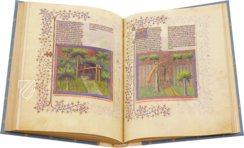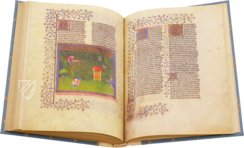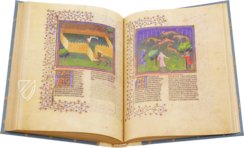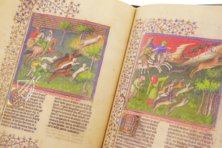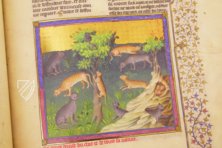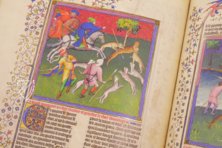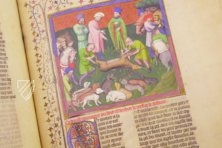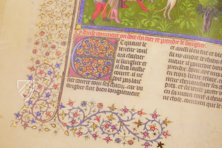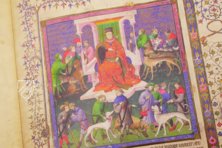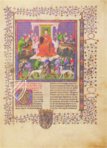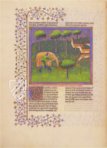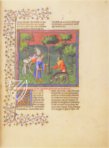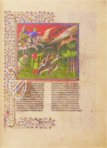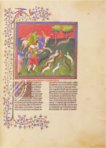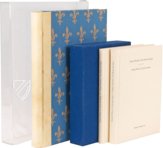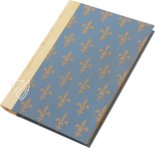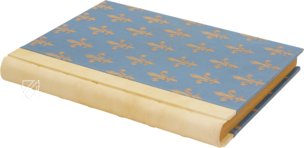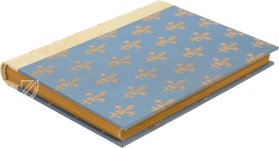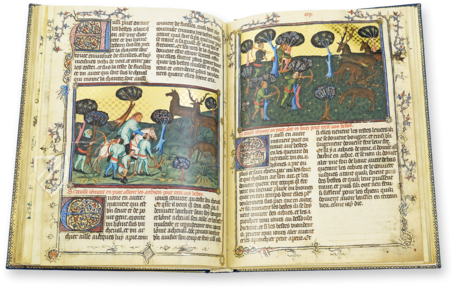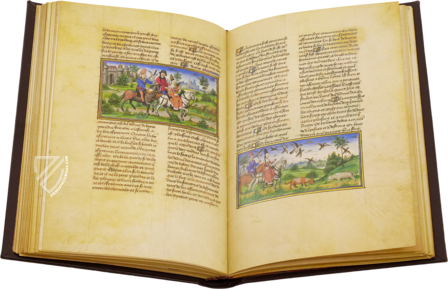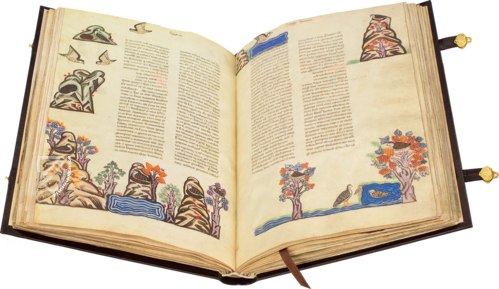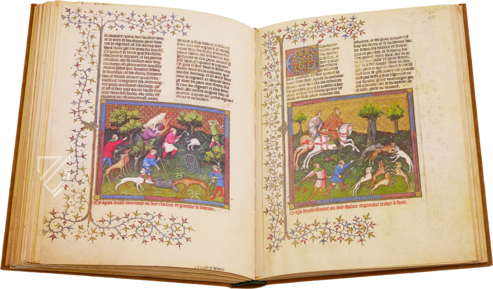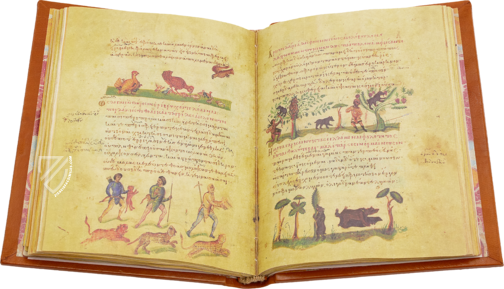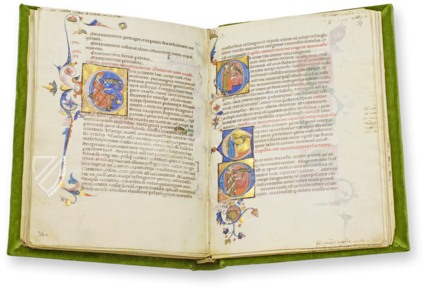Gaston Phoebus – The Master of Game
(1,000€ - 3,000€)
The Master of Game was one of the most popular works of the Middle Ages: it was written between 1387 and 1389 by Gaston Phoebus, a French count, and distributed in numerous copies. It deals with the wide field of hunting, its techniques, the handling of animals, and much more. The most beautiful and splendid copy was made at the court of Philip the Bold in 1407. It is decorated with 87 incredibly beautiful miniatures from the studio of the Bedford Master. The Bedford Master was one of the most talented and famous illuminators of the Middle Ages. Today, the magnificent manuscript is housed in the Morgan Library in New York.
Gaston Phoebus: The Master of Game
In the years 1387 to 1389 the Count of Foix and Viscount of Béarn, named Gaston Pheobus, composed an extensive book concerning the hunt and dedicated it to his hunting companion, Philip the Bold. Le livre de la chasse, its original title in French, has been transmitted into a total of 44 copies. The specimen in the Morgan Library in New York City is considered to be one of the most outstanding reproductions of this manuscript. The hunting book is an interesting cultural testimony and possessed such a great relevance to natural science that it was used as a textbook up until the 19th century. The informative manuscript is incomprehensibly richly adorned with a total of 87 vivid miniatures opulently furnished with gold leaf and brushed gold. In addition to the large-format miniatures, the work is illustrated with 126 great, imaginative initials in a splendid variety of colors.
The Study of Nature in the Middle Ages
The enthusiastic hunter Gaston Phoebus describes the hunt and related activities in his manuscript with great detail. Nonetheless, the work is not merely concerned with the most common forms of hunting. Through his distinct observations of various types of animals, Gaston managed to create a significant masterpiece of medieval natural science long before the age of empirical science. Le livre de la chasse quickly became one of the most popular and widely-read books of the Gothic period. At the French and Burgundian courts, it was not only considered to be a study of nature and a textbook, but also a work of art. Numerous artists sought to translate the legendarily precise descriptions of the book into high-quality miniatures. The masters of the Bedford workshop thereby attained the highest level of refinement. Their illuminated manuscripts are considered by researchers to be among the the most beautiful manuscripts of the Middle Ages.
The Masterwork from the Bedford Studio
Duke Philip the Bold, to whom the original manuscript was dedicated, commissioned the gifted artists for the revision of his book. The artists of the studio of the famous and highly-regarded Bedford Master, created miniatures of surprising and fresh liveliness. Characteristic for their style in particular is a unique handling of plastic forms and faces as well as a soft fall of folds. 87 exceptional miniatures illustrate the manuscript. The exciting pictures in luminous, fresh colors against splendid, variously arranged gold backgrounds enchant each and every beholder. Tender studies of animals and nature and realistic-looking figurative scenes are as persuasive as the sensible treatment of color. The skilled execution of depth and plasticity in the pictures is especially astonishing. Such perspectival, three-dimensional painting was revolutionary for the art of the Middle Ages. No other edition of the hunting book can measure up to this high standard.
Codicology
- Alternative Titles
- Gaston Phoebus - Das Buch der Jagd
- Size / Format
- 252 pages / 38.1 × 29.0 cm
- Origin
- France
- Date
- Ca. 1407
- Epochs
- Style
- Language
- Illustrations
- 87 vivid miniatures, richly ornate with gold leaf and brush gold, 126 large imaginative initials
- Content
- The book has four parts:
On Gentle and Wild Beasts
On the Nature and Care of Dogs
On Instructions for Hunting with Dogs
On Hunting with Traps, Snares, and Crossbow - Patron
- Philip the Bold, Duke of Burgundy (1342–1404)
- Artist / School
- Workshop of the Bedford Master
- Previous Owners
- Louis I, Duke of Orléans (1372–1407)
Francis II, Duke of Brittany (1433 –88)
Queen Isabella I of Castile (1451–1504)
King Ferdinand II of Aragon (1452–1516)
Gaston Phoebus – The Master of Game
A Trap for Wolves
The great unsung struggle of the Middle Ages was the war against wolves – the forests of medieval Europe were overrun with vicious packs of wolves that preyed upon farm animals and people alike. Enclosed within a wattle fence in the middle, we see either a lamb or sheep along with the severed haunch of an animal – perhaps a deer – as bait. One wolf has been drawn into the outer wattle fence and is now trapped between the concentric circles as his comrade looks on helplessly.
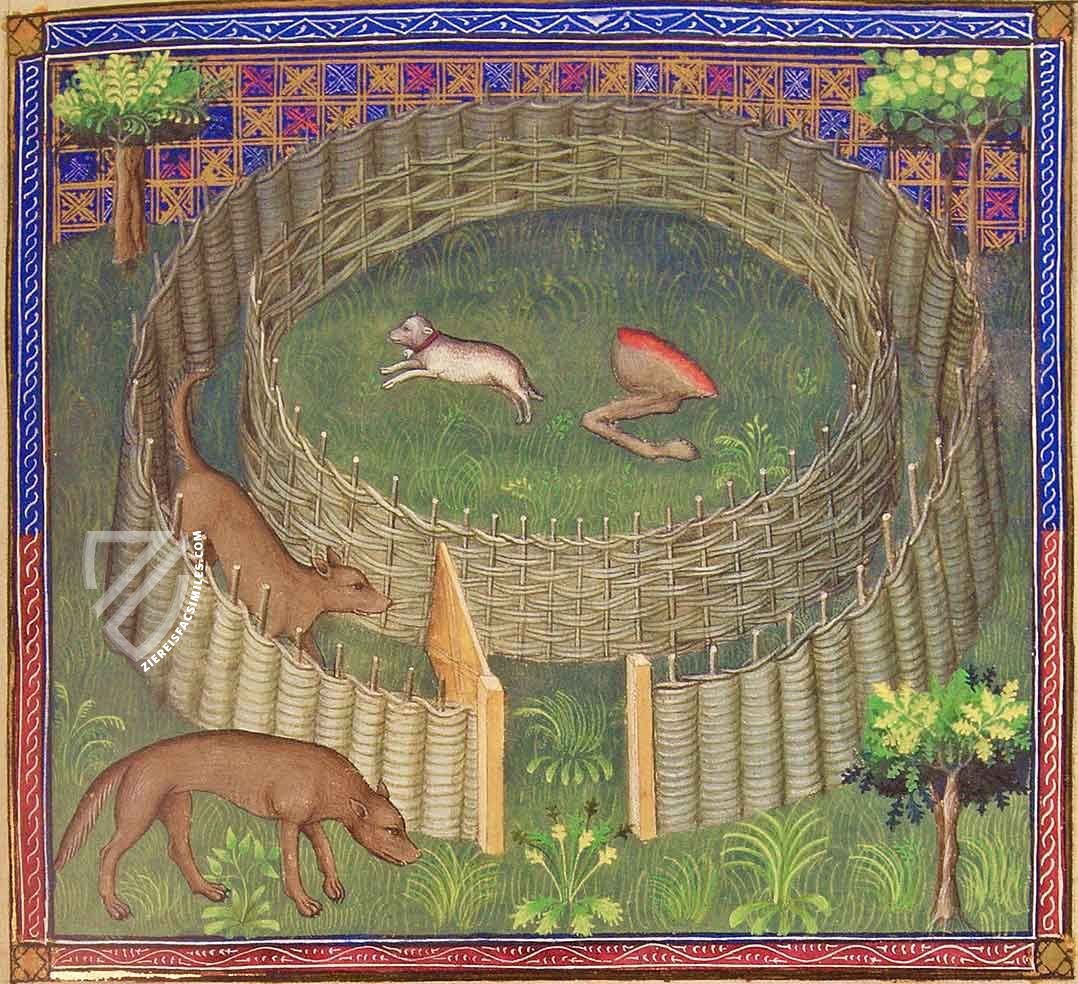
Gaston Phoebus – The Master of Game
Boar Hunting
Wild boar are some of the most dangerous of all game animals, not only willing to attack humans, but known to still be perilous even when fatally wounded. Even with the assistance of fierce dogs, facing off with a boar, spear in hand, was about as close to combat as a knight could get in times of peace.
Despite the violence of the scene, this miniature is truly gorgeous. Dynamic movements, fresh colors, and an elegantly patterned red background combine for a truly masterful composition. A hunter with yellow boots, a curved hunting sword, green tunic, and grey hose and hat stabs a boar in the foreground while a grey dog with a black collar goes in for the kill. Meanwhile, a pack of hunting dogs emerges from the woods, keeping the other boars at bay.
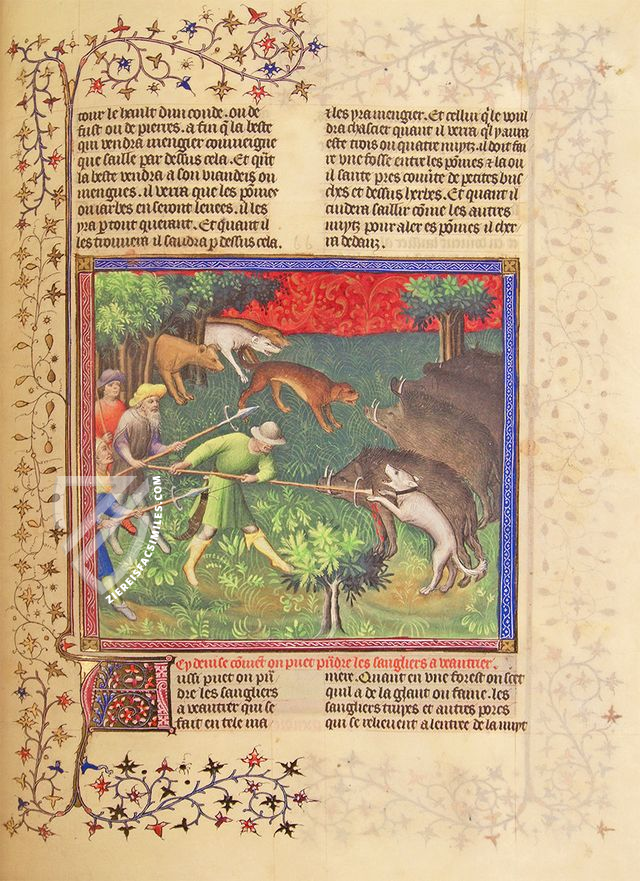
#1 Gaston Phoebus - Das Buch der Jagd
Languages: German, French
The commentary volume includes a transcription and translation of the medieval text as well as a historical and art-historical analysis of the work, thus giving readers a wonderful insight into the aristocratic, courtly culture of the Late Middle Ages.
(1,000€ - 3,000€)
#2 Gaston Phoebus - Das Buch der Jagd (Deluxe Edition)
Languages: German, French
The commentary volume includes a transcription and translation of the medieval text as well as a historical and art-historical analysis of the work, thus giving readers a wonderful insight into the aristocratic, courtly culture of the Late Middle Ages.
- Treatises / Secular Books
- Apocalypses / Beatus
- Astronomy / Astrology
- Bestiaries
- Bibles / Gospels
- Chronicles / History / Law
- Geography / Maps
- Saints' Lives
- Islam / Oriental
- Judaism / Hebrew
- Single Leaf Collections
- Leonardo da Vinci
- Literature / Poetry
- Liturgical Manuscripts
- Medicine / Botany / Alchemy
- Music
- Mythology / Prophecies
- Psalters
- Other Religious Books
- Games / Hunting
- Private Devotion Books
- Other Genres
- Afghanistan
- Armenia
- Austria
- Belgium
- Belize
- Bosnia and Herzegovina
- China
- Colombia
- Costa Rica
- Croatia
- Cyprus
- Czech Republic
- Denmark
- Egypt
- El Salvador
- Ethiopia
- France
- Germany
- Greece
- Guatemala
- Honduras
- Hungary
- India
- Iran
- Iraq
- Israel
- Italy
- Japan
- Jordan
- Kazakhstan
- Kyrgyzstan
- Lebanon
- Liechtenstein
- Luxembourg
- Mexico
- Morocco
- Netherlands
- Palestine
- Panama
- Peru
- Poland
- Portugal
- Romania
- Russia
- Serbia
- Spain
- Sri Lanka
- Sweden
- Switzerland
- Syria
- Tajikistan
- Turkey
- Turkmenistan
- Ukraine
- United Kingdom
- United States
- Uzbekistan
- Vatican City
- A. Oosthoek, van Holkema & Warendorf
- Aboca Museum
- Ajuntament de Valencia
- Akademie Verlag
- Akademische Druck- u. Verlagsanstalt (ADEVA)
- Aldo Ausilio Editore - Bottega d’Erasmo
- Alecto Historical Editions
- Alkuin Verlag
- Almqvist & Wiksell
- Amilcare Pizzi
- Andreas & Andreas Verlagsbuchhandlung
- Archa 90
- Archiv Verlag
- Archivi Edizioni
- Arnold Verlag
- ARS
- Ars Magna
- ArtCodex
- AyN Ediciones
- Azimuth Editions
- Badenia Verlag
- Bärenreiter-Verlag
- Belser Verlag
- Belser Verlag / WK Wertkontor
- Benziger Verlag
- Bernardinum Wydawnictwo
- BiblioGemma
- Biblioteca Apostolica Vaticana (Vaticanstadt, Vaticanstadt)
- Bibliotheca Palatina Faksimile Verlag
- Bibliotheca Rara
- Boydell & Brewer
- Bramante Edizioni
- Bredius Genootschap
- Brepols Publishers
- British Library
- C. Weckesser
- Caixa Catalunya
- Canesi
- CAPSA, Ars Scriptoria
- Caratzas Brothers, Publishers
- Carus Verlag
- Casamassima Libri
- Centrum Cartographie Verlag GmbH
- Chavane Verlag
- Christian Brandstätter Verlag
- Circulo Cientifico
- Club Bibliófilo Versol
- Club du Livre
- CM Editores
- Collegium Graphicum
- Collezione Apocrifa Da Vinci
- Comissão Nacional para as Comemorações dos Descobrimentos Portugueses
- Coron Verlag
- Corvina
- CTHS
- D. S. Brewer
- Damon
- De Agostini/UTET
- De Nederlandsche Boekhandel
- De Schutter
- Deuschle & Stemmle
- Deutscher Verlag für Kunstwissenschaft
- DIAMM
- Droz
- E. Schreiber Graphische Kunstanstalten
- Ediciones Boreal
- Ediciones Grial
- Ediclube
- Edições Inapa
- Edilan
- Editalia
- Edition Deuschle
- Edition Georg Popp
- Edition Leipzig
- Edition Libri Illustri
- Editiones Reales Sitios S. L.
- Éditions de l'Oiseau Lyre
- Editions Medicina Rara
- Editorial Casariego
- Editorial Mintzoa
- Editrice Antenore
- Editrice Velar
- Edizioni Edison
- Egeria, S.L.
- Eikon Editores
- Electa
- Emery Walker Limited
- Enciclopèdia Catalana
- Eos-Verlag
- Ephesus Publishing
- Ernst Battenberg
- Eugrammia Press
- Extraordinary Editions
- Fackelverlag
- Facsimila Art & Edition
- Facsimile Editions Ltd.
- Facsimilia Art & Edition Ebert KG
- Faksimile Verlag
- Feuermann Verlag
- Folger Shakespeare Library
- Franco Cosimo Panini Editore
- Friedrich Wittig Verlag
- Fundación Hullera Vasco-Leonesa
- G. Braziller
- Gabriele Mazzotta Editore
- Gebr. Mann Verlag
- Gesellschaft für graphische Industrie
- Getty Research Institute
- Giovanni Domenico de Rossi
- Giunti Editore
- Graffiti
- Grafica European Center of Fine Arts
- Guido Pressler
- Guillermo Blazquez
- Gustav Kiepenheuer
- H. N. Abrams
- Harrassowitz
- Harvard University Press
- Helikon
- Hendrickson Publishers
- Henning Oppermann
- Herder Verlag
- Hes & De Graaf Publishers
- Hoepli
- Holbein-Verlag
- Houghton Library
- Hugo Schmidt Verlag
- Idion Verlag
- Il Bulino, edizioni d'arte
- ILte
- Imago
- Insel Verlag
- Insel-Verlag Anton Kippenberger
- Instituto de Estudios Altoaragoneses
- Instituto Nacional de Antropología e Historia
- Introligatornia Budnik Jerzy
- Istituto dell'Enciclopedia Italiana - Treccani
- Istituto Ellenico di Studi Bizantini e Postbizantini
- Istituto Geografico De Agostini
- Istituto Poligrafico e Zecca dello Stato
- Italarte Art Establishments
- Jan Thorbecke Verlag
- Johnson Reprint Corporation
- Josef Stocker
- Josef Stocker-Schmid
- Jugoslavija
- Karl W. Hiersemann
- Kasper Straube
- Kaydeda Ediciones
- Kindler Verlag / Coron Verlag
- Kodansha International Ltd.
- Konrad Kölbl Verlag
- Kurt Wolff Verlag
- La Liberia dello Stato
- La Linea Editrice
- La Meta Editore
- Lambert Schneider
- Landeskreditbank Baden-Württemberg
- Leo S. Olschki
- Les Incunables
- Liber Artis
- Library of Congress
- Libreria Musicale Italiana
- Lichtdruck
- Lito Immagine Editore
- Lumen Artis
- Lund Humphries
- M. Moleiro Editor
- Maison des Sciences de l'homme et de la société de Poitiers
- Manuscriptum
- Martinus Nijhoff
- Maruzen-Yushodo Co. Ltd.
- MASA
- Massada Publishers
- McGraw-Hill
- Metropolitan Museum of Art
- Militos
- Millennium Liber
- Müller & Schindler
- Nahar - Stavit
- Nahar and Steimatzky
- National Library of Wales
- Neri Pozza
- Nova Charta
- Oceanum Verlag
- Odeon
- Orbis Mediaevalis
- Orbis Pictus
- Österreichische Staatsdruckerei
- Oxford University Press
- Pageant Books
- Parzellers Buchverlag
- Patrimonio Ediciones
- Pattloch Verlag
- PIAF
- Pieper Verlag
- Plon-Nourrit et cie
- Poligrafiche Bolis
- Presses Universitaires de Strasbourg
- Prestel Verlag
- Princeton University Press
- Prisma Verlag
- Priuli & Verlucca, editori
- Pro Sport Verlag
- Propyläen Verlag
- Pytheas Books
- Quaternio Verlag Luzern
- Reales Sitios
- Recht-Verlag
- Reichert Verlag
- Reichsdruckerei
- Reprint Verlag
- Riehn & Reusch
- Roberto Vattori Editore
- Rosenkilde and Bagger
- Roxburghe Club
- Salerno Editrice
- Saltellus Press
- Sandoz
- Sarajevo Svjetlost
- Schöck ArtPrint Kft.
- Schulsinger Brothers
- Scolar Press
- Scrinium
- Scripta Maneant
- Scriptorium
- Shazar
- Siloé, arte y bibliofilia
- SISMEL - Edizioni del Galluzzo
- Sociedad Mexicana de Antropología
- Société des Bibliophiles & Iconophiles de Belgique
- Soncin Publishing
- Sorli Ediciones
- Stainer and Bell
- Studer
- Styria Verlag
- Sumptibus Pragopress
- Szegedi Tudomànyegyetem
- Taberna Libraria
- Tarshish Books
- Taschen
- Tempus Libri
- Testimonio Compañía Editorial
- Thames and Hudson
- The Clear Vue Publishing Partnership Limited
- The Facsimile Codex
- The Folio Society
- The Marquess of Normanby
- The Richard III and Yorkist History Trust
- Tip.Le.Co
- TouchArt
- TREC Publishing House
- TRI Publishing Co.
- Trident Editore
- Tuliba Collection
- Typis Regiae Officinae Polygraphicae
- Union Verlag Berlin
- Universidad de Granada
- University of California Press
- University of Chicago Press
- Urs Graf
- Vallecchi
- Van Wijnen
- VCH, Acta Humaniora
- VDI Verlag
- VEB Deutscher Verlag für Musik
- Verlag Anton Pustet / Andreas Verlag
- Verlag Bibliophile Drucke Josef Stocker
- Verlag der Münchner Drucke
- Verlag für Regionalgeschichte
- Verlag Styria
- Vicent Garcia Editores
- W. Turnowski Ltd.
- W. Turnowsky
- Waanders Printers
- Wiener Mechitharisten-Congregation (Wien, Österreich)
- Wissenschaftliche Buchgesellschaft
- Wissenschaftliche Verlagsgesellschaft
- Wydawnictwo Dolnoslaskie
- Xuntanza Editorial
- Zakład Narodowy
- Zollikofer AG

